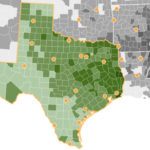Texas has a higher percentage of food-insecure households than the national average, but the total number of households in the state struggling to avoid hunger has decreased since the end of the last recession, according to a new report from the U.S. Department of Agriculture.
Even so, about 1.5 million Texas families lack reliable access to enough affordable and nutritious food to sustain a healthy life.
 “The estimated percentage of U.S. households that were food insecure in 2015 declined significantly from 2014, to 12.7 percent, continuing a downward trend … from a high of 14.9 percent in 2011,” the USDA Economic Research Service report states.
“The estimated percentage of U.S. households that were food insecure in 2015 declined significantly from 2014, to 12.7 percent, continuing a downward trend … from a high of 14.9 percent in 2011,” the USDA Economic Research Service report states.
However, the 2015 prevalence of food insecurity remains above the 2007 pre-recessionary 11.1 percent level.
Texas ranks fourth nationally in food insecurity
Food insecurity varied widely from state to state, from a low of 8.5 percent of North Dakota households to 20.8 percent of Mississippi households.
Texas ranks fourth in terms of percentage of food-insecure households and is among 12 states where food-insecurity exceeds the national average. Others are Alabama, Arkansas, Kentucky, Louisiana, Maine, Mississippi, North Carolina, Ohio, Oklahoma, Oregon and Tennessee.
In 2015, the USDA reported 15.4 percent of Texas households were at risk of hunger, compared to 17.2 percent in the previous year’s report.
Making a difference
Sign up for our weekly edition and get all our headlines in your inbox on Thursdays
Texas is among 11 states where food insecurity declined a statistically significant percentage from 2010-12 to 2013-15, the report noted. Others are California, Florida, Georgia, Hawaii, Illinois, Maryland, Nevada, Rhode Island, South Carolina and Utah.
 Jeremy Everett, founding director of the Texas Hunger Initiative at Baylor University, characterized the overall improvement over the last few years as “incredible news.”
Jeremy Everett, founding director of the Texas Hunger Initiative at Baylor University, characterized the overall improvement over the last few years as “incredible news.”
“We are thrilled to see individuals and families move beyond hunger into food-secure households,” said Everett, who served on the National Commission on Hunger.
“In spite of all the bad news we see reported, this shows that when we choose to be the hands and feet of Christ and to use the gifts of creativity God has bestowed onto his people, that amazing things are happening in our world today.”
Ali Hearon, hunger and care-ministries specialist with the Texas Baptist Christian Life Commission, emphasized the importance of continued Christian involvement in relieving suffering and helping people escape poverty.
“We are so thankful and encouraged to see that fewer families and households worry about where their next meal is coming from, but the work is not done yet,” Hearon said.
“The church is in a special position to make a difference in hunger in Texas. When churches alleviate the immediate, nutritional needs of their neighbor in need or develop long-term solutions to help break cycles of poverty, they are pursuing God’s call to ‘do justice, love kindness and walk humbly with God.’ The Texas Baptist Hunger Offering currently supports 111 ministries actively engaged in ending hunger here in Texas.”
Experts offer different analysis
Some observers differed in their analysis of how significant the change really is from one year’s report to the next. The USDA determines food insecurity based on the average of three-year periods.
When the margins of error are factored for both periods the USDA tracked in its 2014 and 2015 reports, the one-year change in Texas food insecurity was not statistically significant, said Celia Cole, chief executive officer of Feeding Texas.
“Even though the economy supposedly has rebounded in Texas, people are being left behind,” Cole said. “It’s important to note how food insecurity is related to economic insecurity.”
 In contrast, Secretary of Agriculture Tom Vilsack praised the USDA findings as marking “a significant benchmark in our battle against hunger and food security,” particularly among children at risk of hunger.
In contrast, Secretary of Agriculture Tom Vilsack praised the USDA findings as marking “a significant benchmark in our battle against hunger and food security,” particularly among children at risk of hunger.
The report “points to the lowest figures on record for food insecurity among children—a major achievement in our country’s efforts to ensure every child has a safe, healthier future filled with unlimited opportunity,” Vilsack said.
Cole and Vilsack agreed on one point—the need for increased funding for social safety-net programs and additional economic development, particularly in rural areas.
“We must work to preserve the critical Supplemental Nutrition Assistance Program, or SNAP, which prevented millions of Americans from falling into poverty or becoming food insecure during the most difficult stretches of the recession,” Vilsack said. “And we must continue to encourage the public and private sectors alike to invest in our rebounding rural communities—the place that produces our food, fiber and fuel.”














We seek to connect God’s story and God’s people around the world. To learn more about God’s story, click here.
Send comments and feedback to Eric Black, our editor. For comments to be published, please specify “letter to the editor.” Maximum length for publication is 300 words.